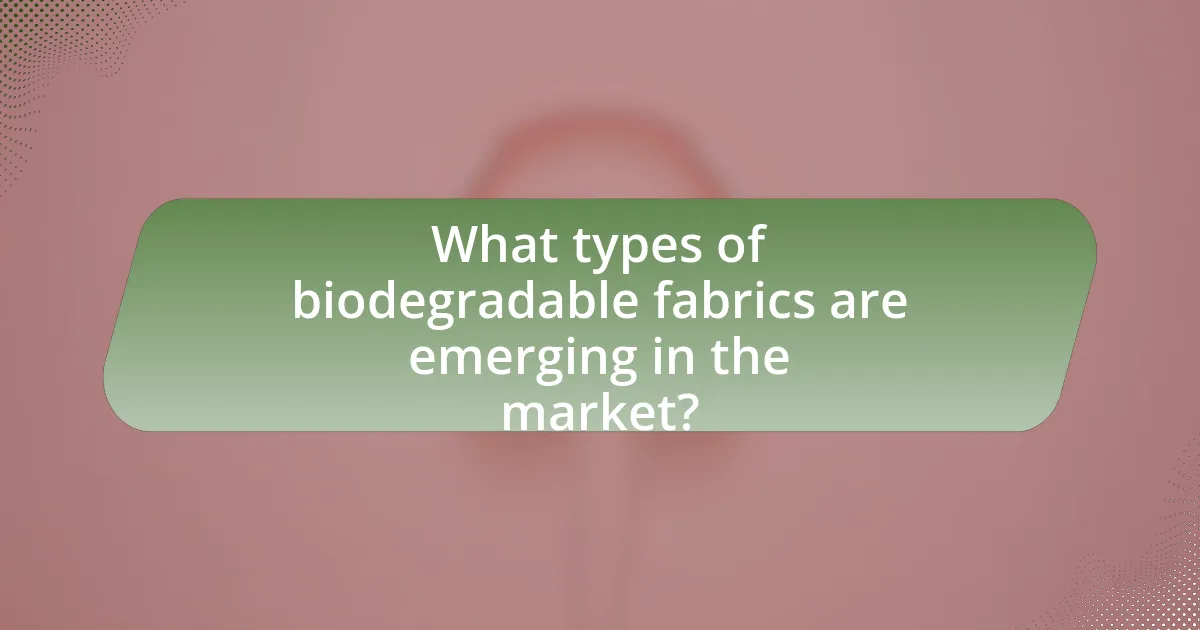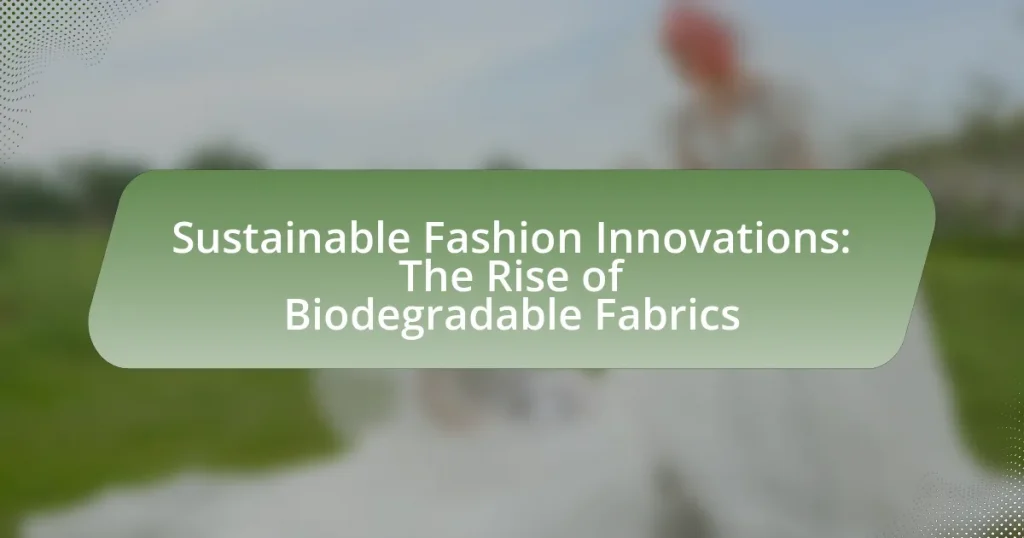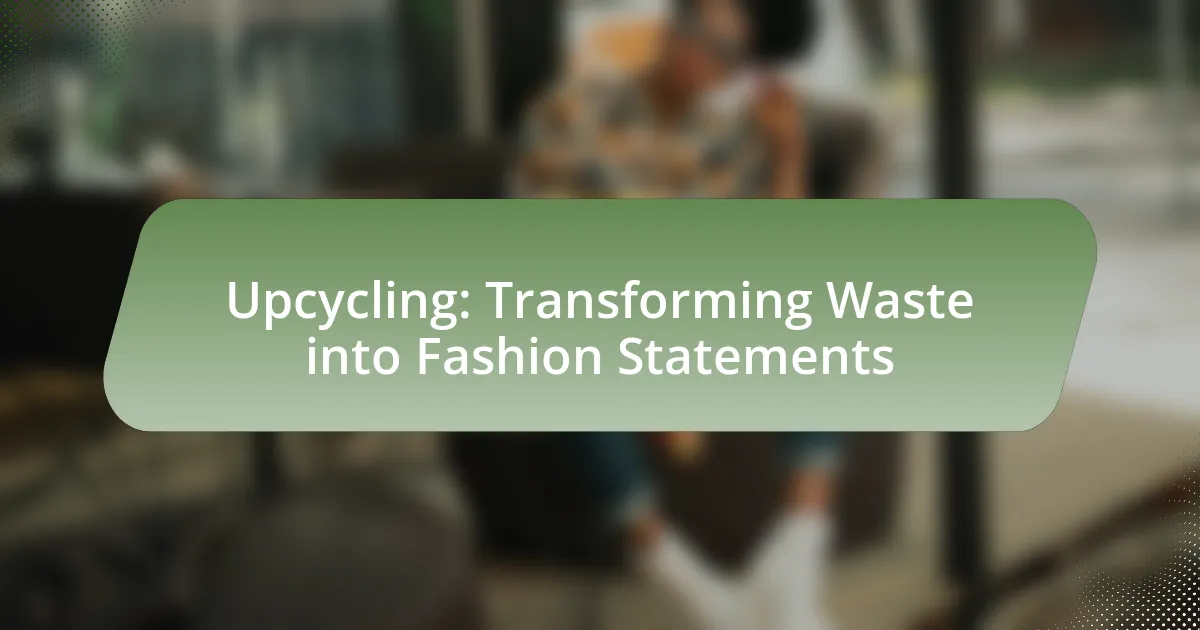Sustainable fashion innovations focus on reducing the environmental impact of the fashion industry through advancements such as biodegradable fabrics. These materials, including Tencel and organic cotton, decompose naturally, minimizing landfill waste and pollution. The article explores the significant impact of these innovations on consumer demand, industry practices, and environmental benefits, while also addressing the challenges of production costs and durability. Key drivers behind the rise of sustainable fashion include increased consumer awareness and regulatory pressures, with a growing market for biodegradable options expected to shape the future of the industry.

What are Sustainable Fashion Innovations?
Sustainable fashion innovations are advancements in the fashion industry aimed at reducing environmental impact and promoting ethical practices. These innovations include the development of biodegradable fabrics, which decompose naturally and minimize waste in landfills. For instance, materials like Tencel, made from sustainably sourced wood pulp, and organic cotton are examples of biodegradable options that reduce reliance on synthetic fibers. According to a report by the Ellen MacArthur Foundation, transitioning to biodegradable materials can significantly decrease the fashion industry’s carbon footprint, highlighting the importance of these innovations in fostering a more sustainable future.
How do Sustainable Fashion Innovations impact the industry?
Sustainable fashion innovations significantly impact the industry by promoting environmentally friendly practices and materials, such as biodegradable fabrics. These innovations reduce waste and pollution, addressing the fashion industry’s substantial environmental footprint, which accounts for approximately 10% of global carbon emissions. For instance, the introduction of biodegradable materials, like Tencel and organic cotton, allows garments to decompose naturally, minimizing landfill contributions. Furthermore, brands adopting these innovations often experience increased consumer demand, as 66% of global consumers are willing to pay more for sustainable products, according to a Nielsen report. This shift not only enhances brand reputation but also drives a broader industry transformation towards sustainability.
What are the key drivers behind the rise of sustainable fashion?
The key drivers behind the rise of sustainable fashion include increased consumer awareness, environmental concerns, and regulatory pressures. Consumers are increasingly prioritizing eco-friendly products, with a 2021 survey indicating that 66% of global consumers are willing to pay more for sustainable brands. Environmental issues, such as pollution and waste generated by the fashion industry, have prompted brands to adopt sustainable practices. Additionally, governments and organizations are implementing regulations aimed at reducing the environmental impact of fashion, further accelerating the shift towards sustainability.
How do consumer preferences influence sustainable fashion trends?
Consumer preferences significantly influence sustainable fashion trends by driving demand for eco-friendly materials and ethical production practices. As consumers increasingly prioritize sustainability, brands respond by adopting biodegradable fabrics and transparent supply chains. For instance, a 2021 survey by McKinsey & Company found that 67% of consumers consider sustainability when making fashion purchases, prompting brands to innovate with materials like organic cotton and recycled polyester. This shift not only reflects consumer values but also shapes the market, leading to a broader acceptance and integration of sustainable practices within the fashion industry.
Why is biodegradable fabric important in sustainable fashion?
Biodegradable fabric is important in sustainable fashion because it reduces environmental impact by decomposing naturally, unlike conventional synthetic fabrics that contribute to landfill waste. The use of biodegradable materials, such as organic cotton or Tencel, minimizes pollution and resource depletion during production and disposal. According to a study by the Ellen MacArthur Foundation, the fashion industry is responsible for 92 million tons of waste annually, much of which is non-biodegradable. By integrating biodegradable fabrics, the industry can significantly lower its ecological footprint and promote a circular economy, where materials are reused and recycled rather than discarded.
What are the environmental benefits of biodegradable fabrics?
Biodegradable fabrics offer significant environmental benefits by reducing waste and pollution. These materials decompose naturally, minimizing landfill contributions and decreasing the accumulation of synthetic textiles that can take hundreds of years to break down. For instance, studies show that traditional polyester can persist in the environment for over 200 years, while biodegradable alternatives like organic cotton or Tencel can decompose within months under the right conditions. Additionally, biodegradable fabrics often require fewer harmful chemicals during production, leading to lower emissions and reduced water contamination. This shift towards biodegradable options supports a circular economy, promoting sustainability in the fashion industry.
How do biodegradable fabrics compare to traditional materials?
Biodegradable fabrics decompose naturally over time, unlike traditional materials such as polyester or nylon, which can take hundreds of years to break down. This decomposition process reduces landfill waste and environmental pollution, as biodegradable fabrics are often made from renewable resources like organic cotton, hemp, or Tencel. Studies indicate that biodegradable fabrics can significantly lower the environmental impact of the fashion industry, which is responsible for substantial carbon emissions and waste. For example, a report by the Ellen MacArthur Foundation highlights that the fashion industry could reduce its greenhouse gas emissions by 1.1 billion tons annually by adopting biodegradable materials.

What types of biodegradable fabrics are emerging in the market?
Emerging biodegradable fabrics in the market include Tencel, made from sustainably sourced wood pulp, and Piñatex, derived from pineapple leaf fibers. Tencel is known for its softness and moisture-wicking properties, while Piñatex offers a leather alternative that utilizes agricultural waste. Additionally, fabrics like organic cotton and hemp are gaining traction due to their natural biodegradability and lower environmental impact. Research indicates that these materials can decompose within a few months to a few years, significantly reducing landfill waste compared to conventional synthetic fabrics.
How are these fabrics produced?
Biodegradable fabrics are produced through processes that utilize natural materials, such as organic cotton, hemp, or fibers derived from plants like bamboo and corn. These materials undergo methods like spinning, weaving, or knitting to create textiles that can decompose naturally over time. For instance, fibers from corn starch are processed into polylactic acid (PLA), which is then spun into yarn and woven into fabric. This production method not only reduces reliance on synthetic fibers but also minimizes environmental impact, as these fabrics can break down in composting conditions within a few months to a few years, unlike traditional plastics that can take centuries to decompose.
What raw materials are used in the creation of biodegradable fabrics?
Biodegradable fabrics are primarily created from natural raw materials such as organic cotton, hemp, linen, and bamboo. These materials are chosen for their ability to decompose naturally over time, reducing environmental impact. For instance, organic cotton is cultivated without synthetic pesticides, while hemp and bamboo grow rapidly and require less water, making them sustainable options. Additionally, biodegradable fabrics can also be made from regenerated fibers like Tencel, which is derived from sustainably sourced wood pulp. These raw materials contribute to the overall sustainability of biodegradable fabrics by ensuring they break down efficiently in the environment.
What technologies are involved in the production process?
The technologies involved in the production process of biodegradable fabrics include biopolymer synthesis, enzymatic processing, and 3D printing. Biopolymer synthesis utilizes renewable resources such as corn or sugarcane to create materials like polylactic acid (PLA), which is biodegradable. Enzymatic processing employs specific enzymes to break down natural fibers, enhancing their biodegradability and reducing environmental impact. Additionally, 3D printing technology allows for the precise fabrication of biodegradable textiles, minimizing waste during production. These technologies collectively contribute to the development of sustainable fashion by reducing reliance on non-renewable resources and promoting eco-friendly practices.
What are the applications of biodegradable fabrics in fashion?
Biodegradable fabrics in fashion are primarily applied in clothing production, accessories, and packaging materials. These fabrics, made from natural fibers like organic cotton, hemp, and Tencel, decompose more easily than conventional materials, reducing environmental impact. For instance, brands like Stella McCartney and Eileen Fisher utilize biodegradable textiles to create sustainable collections, demonstrating a commitment to eco-friendly practices. Additionally, biodegradable fabrics are increasingly used in packaging for fashion items, minimizing plastic waste and promoting a circular economy. This shift towards biodegradable materials aligns with consumer demand for sustainable fashion, as evidenced by a 2021 survey indicating that 66% of global consumers are willing to pay more for sustainable brands.
Which fashion brands are leading the way in using biodegradable fabrics?
Patagonia, Stella McCartney, and Eileen Fisher are leading the way in using biodegradable fabrics. Patagonia has developed a line of biodegradable materials, including organic cotton and hemp, which decompose naturally. Stella McCartney is known for her commitment to sustainability, utilizing biodegradable fabrics like Tencel and organic cotton in her collections. Eileen Fisher focuses on eco-friendly practices, incorporating biodegradable fibers such as linen and organic cotton into her designs. These brands exemplify the shift towards sustainable fashion by prioritizing materials that minimize environmental impact.
How do biodegradable fabrics perform in terms of durability and wearability?
Biodegradable fabrics generally exhibit lower durability and wearability compared to conventional synthetic materials. For instance, fabrics made from natural fibers like organic cotton or hemp tend to degrade more quickly under environmental conditions, which can lead to reduced lifespan and performance in everyday use. Research indicates that while biodegradable fabrics can be suitable for short-term applications, their susceptibility to wear and tear, moisture absorption, and UV exposure can compromise their longevity. Studies have shown that biodegradable textiles may lose structural integrity after repeated washing cycles, making them less ideal for long-lasting garments.

What challenges do biodegradable fabrics face in the fashion industry?
Biodegradable fabrics face significant challenges in the fashion industry, primarily related to production costs, durability, and consumer awareness. The production of biodegradable materials often requires specialized processes and raw materials, which can lead to higher costs compared to conventional fabrics. For instance, materials like Tencel and organic cotton, while biodegradable, can be more expensive to produce due to the sustainable farming practices and processing methods involved.
Additionally, the durability of biodegradable fabrics can be a concern; they may not withstand the same wear and tear as synthetic alternatives, leading to shorter product lifespans. This can deter consumers who prioritize longevity in their purchases. Furthermore, there is a lack of widespread consumer awareness regarding the benefits and proper care of biodegradable fabrics, which can hinder market acceptance. According to a survey by McKinsey & Company, only 15% of consumers are aware of biodegradable options in fashion, indicating a significant gap in knowledge that needs to be addressed for these materials to gain traction in the market.
How do cost and scalability affect the adoption of biodegradable fabrics?
Cost and scalability significantly influence the adoption of biodegradable fabrics by determining their market viability and accessibility. High production costs can deter manufacturers from investing in biodegradable materials, as they may not compete effectively with cheaper synthetic alternatives. For instance, the production of biodegradable fabrics often involves advanced technologies and raw materials that can be more expensive than conventional fabrics, leading to higher retail prices. Additionally, scalability is crucial; if manufacturers cannot produce biodegradable fabrics at a large scale, the supply may not meet consumer demand, limiting their availability in the market. Research indicates that achieving economies of scale can reduce costs and enhance the competitiveness of biodegradable fabrics, making them more appealing to both producers and consumers.
What are the economic implications for manufacturers?
The economic implications for manufacturers in the context of sustainable fashion innovations, particularly biodegradable fabrics, include increased production costs and potential market advantages. Manufacturers may face higher initial costs due to the investment in new technologies and materials required for biodegradable fabrics, which can impact profit margins. However, these manufacturers can also benefit from a growing consumer demand for sustainable products, leading to increased sales and market share. According to a report by McKinsey & Company, the global market for sustainable fashion is projected to reach $8.25 billion by 2023, indicating significant economic opportunities for manufacturers who adapt to these trends.
How does consumer awareness impact the market for biodegradable fabrics?
Consumer awareness significantly drives the market for biodegradable fabrics by increasing demand for sustainable products. As consumers become more informed about environmental issues, they actively seek alternatives to conventional fabrics that contribute to pollution and waste. This heightened awareness has led to a surge in the popularity of biodegradable options, with a report from Grand View Research indicating that the global biodegradable fabrics market is expected to reach $1.5 billion by 2025, growing at a CAGR of 12.5%. Consequently, brands are responding by investing in research and development of biodegradable materials, aligning their offerings with consumer preferences for eco-friendly solutions.
What regulatory and certification standards exist for biodegradable fabrics?
Regulatory and certification standards for biodegradable fabrics include the Global Organic Textile Standard (GOTS), which ensures organic status and environmental criteria, and the ASTM D6400 standard, which specifies the requirements for biodegradable plastics in composting. Additionally, the European Union’s EN 13432 standard outlines the criteria for packaging recoverable through composting and biodegradation. These standards are crucial for verifying the biodegradability and environmental impact of fabrics, ensuring they meet specific criteria for sustainability and consumer safety.
How do these standards ensure the sustainability of biodegradable fabrics?
Standards ensure the sustainability of biodegradable fabrics by establishing criteria for material composition, production processes, and end-of-life disposal. These criteria mandate that biodegradable fabrics must decompose within a specific timeframe in natural environments, reducing landfill waste and environmental impact. For instance, the Global Organic Textile Standard (GOTS) requires that materials are made from organic fibers and processed without harmful chemicals, promoting eco-friendly practices. Additionally, standards like the ASTM D6400 specify the conditions under which materials can be considered compostable, ensuring that biodegradable fabrics break down effectively in composting systems. This regulatory framework supports sustainable practices by encouraging manufacturers to adopt environmentally responsible methods, ultimately contributing to a circular economy in the fashion industry.
What role do certifications play in consumer trust and brand reputation?
Certifications significantly enhance consumer trust and brand reputation by providing verified assurance of product quality and sustainability. When brands obtain certifications related to biodegradable fabrics, such as Global Organic Textile Standard (GOTS) or OEKO-TEX, they demonstrate compliance with rigorous environmental and social standards. This transparency fosters consumer confidence, as studies show that 66% of consumers are willing to pay more for sustainable brands, indicating that certifications can directly influence purchasing decisions and brand loyalty. Furthermore, brands with recognized certifications often experience improved market positioning, as consumers increasingly prioritize ethical and sustainable practices in their buying behavior.
What future trends can we expect in biodegradable fabrics and sustainable fashion?
Future trends in biodegradable fabrics and sustainable fashion include the increased use of plant-based materials, advancements in textile recycling technologies, and a shift towards circular fashion models. Plant-based materials, such as those derived from hemp, organic cotton, and innovative sources like mycelium, are gaining traction due to their lower environmental impact compared to conventional fabrics. Research indicates that the global biodegradable fabrics market is projected to grow significantly, driven by consumer demand for eco-friendly products and regulatory pressures for sustainable practices. Additionally, advancements in recycling technologies are enabling the recovery and reuse of materials, reducing waste and promoting sustainability. Circular fashion models, which emphasize the lifecycle of garments and encourage recycling and upcycling, are becoming more prevalent, aligning with the principles of sustainable fashion.
How might technological advancements shape the future of biodegradable fabrics?
Technological advancements will significantly enhance the development and performance of biodegradable fabrics by improving their durability, production efficiency, and environmental impact. Innovations such as bioengineering and nanotechnology enable the creation of stronger, more resilient materials that decompose effectively without leaving harmful residues. For instance, research has shown that using enzymes in the production process can accelerate biodegradation while maintaining fabric integrity, as demonstrated in studies published in the Journal of Cleaner Production. Additionally, advancements in sustainable sourcing of raw materials, such as lab-grown fibers, can reduce reliance on traditional agriculture, further minimizing environmental footprints. These developments collectively position biodegradable fabrics as a viable alternative in the sustainable fashion industry.
What role will consumer activism play in the evolution of sustainable fashion?
Consumer activism will significantly drive the evolution of sustainable fashion by demanding transparency and ethical practices from brands. As consumers increasingly prioritize sustainability, they influence companies to adopt eco-friendly materials and production methods, such as biodegradable fabrics. For instance, a 2021 survey by McKinsey & Company found that 67% of consumers consider sustainability when making a purchase, prompting brands to innovate and align with these values. This shift not only encourages the development of sustainable products but also holds companies accountable for their environmental impact, fostering a market that prioritizes sustainability.
What practical steps can consumers take to support sustainable fashion innovations?
Consumers can support sustainable fashion innovations by choosing to purchase biodegradable fabrics and brands that prioritize eco-friendly practices. By selecting clothing made from materials like organic cotton, Tencel, or hemp, consumers directly contribute to reducing environmental impact, as these fabrics are designed to decompose naturally and minimize waste. Additionally, supporting brands that implement sustainable production methods, such as using low-impact dyes and ethical labor practices, reinforces the demand for responsible fashion. Research indicates that the global market for sustainable fashion is projected to reach $8.25 billion by 2023, highlighting a growing consumer preference for eco-conscious choices.




